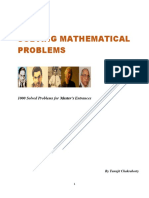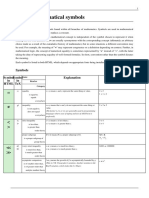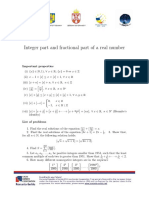Introduction To Algorithms: Problem Set 1 Solutions
Uploaded by
sasan_codeIntroduction To Algorithms: Problem Set 1 Solutions
Uploaded by
sasan_codeIntroduction to Algorithms: 6.
006 Problem Set 2
Massachusetts Institute of Technology Feb 9, 2012
Problem Set 1 Solutions
1. (15 points) Order of Growth
For each group of functions, sort the functions in increasing order of asymptotic (big-
O) complexity. Partition each group into equivalence classes such that f
i
(n) and f
j
(n)
are in the same class if and only if f
i
(n) = (f
j
(n)). (You do not need to show your
work for this problem.)
(a) (5 points) Group A:
f
1
(n) = nlog n
f
2
(n) = n + 100
f
3
(n) = 10n
f
4
(n) = 1.01
n
f
5
(n) =
n (log n)
3
Solution:
[[5],[2,3],[1],[4]]
We observe that f
5
has the smallest order of growth, since it grows sublinearly.
(Recall that log n = o(n
) for any > 0.) Next, f
2
= (f
3
), since additive
and multiplicative constants do not aect asymptotic growth. We know that
nlog n = (n), and nally the largest growth is 1.01
n
, which grows exponentially.
(b) (5 points) Group B:
f
1
(n) = 2
n
f
2
(n) = 2
2n
f
3
(n) = 2
n+1
f
4
(n) = 10
n
Solution:
[[1,3],[2],[4]]
We observe that 2
n
and 2
n+1
are in the same equivalence class, since they dier
only by a factor of two (and constant multiples do not matter.) Next, we observe
that f
2
= (f
1
), since
lim
n
2
2n
2
n
= lim
n
2
n
= .
2 Problem Set 1 Solutions
Finally, 10
n
= (2
2n
), since
lim
n
10
n
2
2n
= lim
n
2
n
5
n
2
n
2
n
= lim
n
5
2
n
= .
(c) (5 points) Group C:
f
1
(n) = n
n
f
2
(n) = n!
f
3
(n) = 2
n
f
4
(n) = 10
10
100
Solution:
[[4],[3],[2],[1]]
The smallest order of growth is clearly f
4
, since constant functions are (1). Next,
we observe that 2
n
= o(n!), since
lim
n
n!
2
n
= lim
n
1
2
2
2
3
2
n
2
lim
n
1
2
3
2
n2
= .
Finally, the fact that n! = o(n
n
) follows from Stirlings approximation that n!
2n
n
e
n
, and noting that
n
n
2n
n
e
n
=
1
2ne
n
=
e
n
2n
which goes to as n . We can also prove that n! = o(n
n
) directly by
expanding n! and n
n
to notice that n
n
/n!
n
2
, which goes to as n .
2. (10 points) Recurrence Relations
(a) (5 points) What is the asymptotic complexity of an algorithm with runtime given
by the recurrence:
T(n) = 4T(n/2) + log n.
1. (n)
2. (nlog n)
3. (n
2
)
4. (n
2
log n)
Solution:
3
Problem Set 1 Solutions 3
The easiest way to see this is by the master theorem, since n
log
2
4
= n
2
, and
log n = o(n
2
). We can also solve this problem by expanding the recurrence to
obtain a sum, and noting that the largest term in the sum dictates the asymptotic
behavior. (Each subsequent term is less than half of the previous term, and
therefore the entire sum is bounded by a constant multiple of the rst term.)
(b) (5 points) What is the asymptotic complexity of an algorithm with runtime given
by the recurrence:
T(n) = 9T(n/3) + n
2
.
1. (nlog n)
2. (n
2
)
3. (n
2
log n)
4. (n
3
)
Solution:
3
This follows by the master theorem, since n
log
3
9
= n
2
. Since the additive term has the
same asymptotic growth as n
log
3
9
, we gain an extra log factor.
3. (20 points) 2D Peak Finding
Consider the following approach for nding a peak in an (n n) matrix:
1. Find a maximum element m in the middle column of the matrix.
If the the left neighbor of m is greater than it, discard the center column and
the right half of the matrix.
Else, if the right neighbor of m is greater than it, discard the center column
and the left half of the matrix.
Otherwise, stop and return m.
2. Find a maximum element m
in the middle row of the remaining matrix.
If the the upper neighbor of m
is greater than it, discard the center row and
the bottom half of the matrix.
Else, if the lower neighbor of m
is greater than it, discard the center row and
the top half of the matrix.
Otherwise, stop and return m
.
3. Go back to step 1.
(a) (5 points) Let the worst-case running time of this algorithm on an (nn) matrix
be T(n). State a recurrence for T(n). (You may assume that it takes constant
time to discard parts of the matrix.)
Solution:
4 Problem Set 1 Solutions
T(n) = T(n/2) + \Theta(n)
In each iteration, we reduce an n n matrix to a n/2 n/2 submatrix. Do-
ing so requires (n) work, since we must check all elements in the appropriate
row/column.
(b) (5 points) Solve this recurrence to nd the asymptotic behavior of T(n).
T(n) = \Theta(n)
This follows by expanding the recurrence. We can bound the (n) terms above
or below by cn, and then bound T(n) by
cn +
cn
4
+
cn
8
+
cn
16
+ 2cn.
(c) (10 points) Prove that this algorithm always nds a peak, or give a small (n 7)
counterexample on which it does not.
Solution: This algorithm does not always nd a peak. One possible counterexample
matrix is given below.
[[0,0,0,3,2,1,0],
[0,0,0,0,0,0,0],
[0,0,0,0,7,0,0],
[0,0,0,4,6,0,0],
[0,0,0,0,0,0,0],
[0,0,0,0,0,0,0],
[0,0,0,0,0,0,0]]
When we run the algorithm, it will return 2 in location (0, 4), which is not a peak.
The algorithm will rst nd that 4 is the maximum element in the middle column, and
therefore recurse on the right half of the matrix (since 4 is adjacent to 6). It will then
nd that 6 is the maximum element in right half of the middle row, and will therefore
recurse on the upper right quadrant (since 7 is adjacent to 6). It will then nd that
1 is the maximum element in the middle column of the 3 3 upper-right submatrix,
and will therefore discard all but the top three elements in the column beginning with
2. Finally, it will return 2 in location (0, 4) as the answer, since 2 is above the 0 in
location (1, 4) and is greater than it.
4. (30 points) Programming Exercise: Peak In Circle
Write a function find peak in circle that eciently nds a peak value in a circle of
integers. This function should take a list of integers as an input. Two elements in this
list are adjacent if they are consecutive elements of the list or if they are the rst and
Problem Set 1 Solutions 5
last element. A peak is an element of the list which is greater than both of its adjacent
elements - your goal is to nd the value of any peak.
You may assume that the input list is non-empty. However, you may not change the
entries of the list, and your function should also accept (immutable) tuples. Here are
some example test cases that your function should agree with:
# Both 4 and 5 are peaks in the array [1, 2, 5, 3, 4]
find_peak_in_circle([1, 2, 5, 3, 4]) in (4, 5)
# The element 3 is not a peak in [3, 2, 1, 4] because it is adjacent to 4
find_peak_in_circle([3, 2, 1, 4]) == 4
Solution: An example algorithm is below. Notice that in this algorithm we keep track
of the bounds into the array (instead of copying the array with each recursion) and
we recurse on the side containing the maximum element we have seen thus far. This
algorithm has worst-case running time (log n).
def find_peak_in_circle(input):
max_location = 0
if input[-1] > input[0]:
max_location = len(input) - 1
min_bound = 0
max_bound = len(input)
while min_bound < max_bound - 1:
mid = (min_bound + max_bound) / 2
if input[mid] < input[max_location]:
if mid < max_location:
min_bound = mid + 1
else:
max_bound = mid
elif mid + 1 < max_bound and input[mid + 1] > input[mid]:
max_location = mid + 1
min_bound = mid + 1
elif input[mid - 1] > input[mid]:
max_location = mid - 1
max_bound = mid
else:
return input[mid]
return input[max_location]
You might also like
- Anselin, Luc. (1988) - Spatial Econometrics PDFNo ratings yetAnselin, Luc. (1988) - Spatial Econometrics PDF294 pages
- 17 Dynamic Programming Matrix Chain Multiplication No PauseNo ratings yet17 Dynamic Programming Matrix Chain Multiplication No Pause32 pages
- TrinMaC Virtual Winter 2022 Final ProblemsNo ratings yetTrinMaC Virtual Winter 2022 Final Problems5 pages
- Extra Practice Key Topic 1.4 Graphing Calculators and ExtremaNo ratings yetExtra Practice Key Topic 1.4 Graphing Calculators and Extrema1 page
- Dca2101 - Computer Oriented Numerical MethodsNo ratings yetDca2101 - Computer Oriented Numerical Methods9 pages
- SME IX Integer Part and Fractional Part PDFNo ratings yetSME IX Integer Part and Fractional Part PDF2 pages
- 14.2.7 - Numerical Approximation Euler's MethodNo ratings yet14.2.7 - Numerical Approximation Euler's Method23 pages
- 2022 Pascal Contest: The Centre For Education in Mathematics and Computing Cemc - Uwaterloo.caNo ratings yet2022 Pascal Contest: The Centre For Education in Mathematics and Computing Cemc - Uwaterloo.ca257 pages
- 1.3 Floating Point Number Systems: Full DownloadNo ratings yet1.3 Floating Point Number Systems: Full Download13 pages
- Complete Answer Guide for Solution Manual for Introduction to the Design and Analysis of Algorithms, 3/E 3rd Edition Anany Levitin100% (20)Complete Answer Guide for Solution Manual for Introduction to the Design and Analysis of Algorithms, 3/E 3rd Edition Anany Levitin58 pages
- Numerical Linear Algebra University of Edinburgh Past Paper 2020-2021100% (1)Numerical Linear Algebra University of Edinburgh Past Paper 2020-20214 pages
- MAT3707 - Discrete Mathematics Assignment 1No ratings yetMAT3707 - Discrete Mathematics Assignment 13 pages
- MA (Improper Integrals & Comparison Test For Improper Integrals)No ratings yetMA (Improper Integrals & Comparison Test For Improper Integrals)5 pages
- 06 9MA0 01 9MA0 02 A Level Pure Mathematics Practice Set 6No ratings yet06 9MA0 01 9MA0 02 A Level Pure Mathematics Practice Set 66 pages
- MIR Vilenkin N Combinatorial Mathematics For Recreation 1972 PDFNo ratings yetMIR Vilenkin N Combinatorial Mathematics For Recreation 1972 PDF205 pages
- The Finite Element Method for Stress AnalysisNo ratings yetThe Finite Element Method for Stress Analysis47 pages
- Goldenbaum, Ursula, Ursula Goldenbaum, Douglas Jesseph Infinitesimal Differences Controversies Between Leibniz and His Contemporaries 2008 PDFNo ratings yetGoldenbaum, Ursula, Ursula Goldenbaum, Douglas Jesseph Infinitesimal Differences Controversies Between Leibniz and His Contemporaries 2008 PDF336 pages
- Addis Ababa Science & Technology University Department of Electrical & Computer EngineeringNo ratings yetAddis Ababa Science & Technology University Department of Electrical & Computer Engineering63 pages
- Fire Protection of Buildings: Building Construction IV, August 2010No ratings yetFire Protection of Buildings: Building Construction IV, August 20109 pages
- Artificial Intelligence (Trí tuệ nhân tạo) : Solving Problems by searching (Giải quyết vấn đề bằng tìm kiếm)No ratings yetArtificial Intelligence (Trí tuệ nhân tạo) : Solving Problems by searching (Giải quyết vấn đề bằng tìm kiếm)123 pages
- Filippou-Popov-Bertero, Modeling of RC Joints, ASCE 1983No ratings yetFilippou-Popov-Bertero, Modeling of RC Joints, ASCE 198320 pages
- Altec 828 Horn Flare Cut Details 12-5-2020No ratings yetAltec 828 Horn Flare Cut Details 12-5-20201 page
- Geometric Design Tolerancing - Theories, Standards and ApplicationsNo ratings yetGeometric Design Tolerancing - Theories, Standards and Applications467 pages
- 17 Dynamic Programming Matrix Chain Multiplication No Pause17 Dynamic Programming Matrix Chain Multiplication No Pause
- Extra Practice Key Topic 1.4 Graphing Calculators and ExtremaExtra Practice Key Topic 1.4 Graphing Calculators and Extrema
- 2022 Pascal Contest: The Centre For Education in Mathematics and Computing Cemc - Uwaterloo.ca2022 Pascal Contest: The Centre For Education in Mathematics and Computing Cemc - Uwaterloo.ca
- Complete Answer Guide for Solution Manual for Introduction to the Design and Analysis of Algorithms, 3/E 3rd Edition Anany LevitinComplete Answer Guide for Solution Manual for Introduction to the Design and Analysis of Algorithms, 3/E 3rd Edition Anany Levitin
- Numerical Linear Algebra University of Edinburgh Past Paper 2020-2021Numerical Linear Algebra University of Edinburgh Past Paper 2020-2021
- MA (Improper Integrals & Comparison Test For Improper Integrals)MA (Improper Integrals & Comparison Test For Improper Integrals)
- 06 9MA0 01 9MA0 02 A Level Pure Mathematics Practice Set 606 9MA0 01 9MA0 02 A Level Pure Mathematics Practice Set 6
- MIR Vilenkin N Combinatorial Mathematics For Recreation 1972 PDFMIR Vilenkin N Combinatorial Mathematics For Recreation 1972 PDF
- Goldenbaum, Ursula, Ursula Goldenbaum, Douglas Jesseph Infinitesimal Differences Controversies Between Leibniz and His Contemporaries 2008 PDFGoldenbaum, Ursula, Ursula Goldenbaum, Douglas Jesseph Infinitesimal Differences Controversies Between Leibniz and His Contemporaries 2008 PDF
- Addis Ababa Science & Technology University Department of Electrical & Computer EngineeringAddis Ababa Science & Technology University Department of Electrical & Computer Engineering
- Fire Protection of Buildings: Building Construction IV, August 2010Fire Protection of Buildings: Building Construction IV, August 2010
- Artificial Intelligence (Trí tuệ nhân tạo) : Solving Problems by searching (Giải quyết vấn đề bằng tìm kiếm)Artificial Intelligence (Trí tuệ nhân tạo) : Solving Problems by searching (Giải quyết vấn đề bằng tìm kiếm)
- Filippou-Popov-Bertero, Modeling of RC Joints, ASCE 1983Filippou-Popov-Bertero, Modeling of RC Joints, ASCE 1983
- Geometric Design Tolerancing - Theories, Standards and ApplicationsGeometric Design Tolerancing - Theories, Standards and Applications

























































































